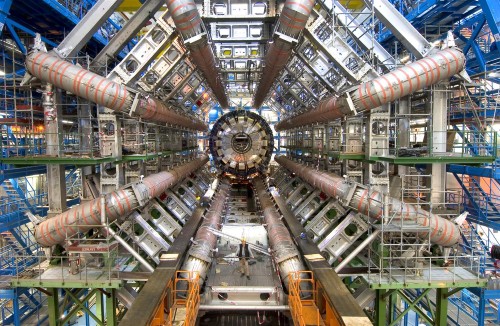
By Hamish Johnston
Excitement levels in the world of particle physics hit the roof this week as further evidence emerged that physicists working on the Large Hadron Collider (LHC) may have caught sight of a new particle that is not described by the Standard Model of particle physics. If this turns out to be true, it will be the most profound discovery in particle physics in decades and would surely lead to a Nobel prize.
In December 2015 I wrote about a curious bump that appears in data from the ATLAS and CMS experiments on the LHC. The bump appears at about 750 GeV and could be indicative of the existence of a brand new boson with a mass of 750 GeV/c2. In December were told that ATLAS had spotted the bump with a statistical significance of 3.6σ – much lower than the 5σ required for a discovery in particle physics.
Now, the ATLAS team has performed a different analysis of its data and again found the bump with a similar significance. This suggests that the first analysis was not some sort of fluke. Furthermore, physicists working on the CMS experiment on the LHC have announced that they have spotted the bump with a significance of 3.4σ, up from their previous value of 2.6σ.
These announcements were made yesterday at the 51st Rencontres de Moriond conference, where rumours were flying that an alternative (but as yet unreleased) analysis by ATLAS puts the significance up to 4.7σ. As ever, there is excellent in-depth analysis of the bump on the Résonaances blog: “Diphoton update”.
“Heat rises” is something that everyone learns in school. This simple fact plays a crucial role in how fires spread here on Earth. Flames and smoke flow upwards, while oxygen-rich air is pulled in from below. But what if you take away gravity? Would the smoke just hang around the flame, preventing fresh oxygen from stoking the fire? Engineers at NASA’s Glenn Research Center in Cleveland, Ohio, are trying to answer these questions by burning things in space. The first of three experiments will launch on 22 March and will involve burning a large sample of material that is typically used in space missions.
Neil Turok is one of the most eloquent physicists I know, especially when it comes to explaining very complicated ideas. In a programme recorded for Canada’s CBC Radio, the director of the Perimeter Institute for Theoretical Physics tells journalist Paul Kennedy why he believes the future is bright for physicists. Given the recent excitement at CERN, I couldn’t agree more.



